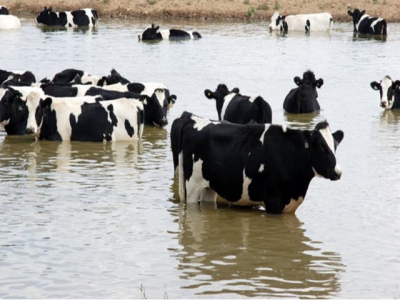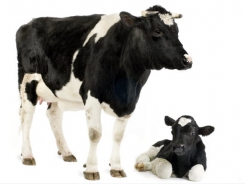Organic selenium may support cows through heat stress trials

Supplementing dairy cow diets with organic selenium during a heat stress challenge may limit oxidative stress damage, boost milk yield and improve total antioxidant capacity, say researchers.
An international team of researchers from China, the US and Spain explored the use of different types of supplemental selenium (Se) – inorganic sodium selenite (SS) or organic hydroxy-selenomethionine (HMSeBA) – to support dairy cow production during a period of stress.
“We hypothesized that HMSeBA supplementation would decrease oxidative stress during HS [heat stress],” the researchers said. “Therefore, our current study objectives were to investigate the effects of HMSeBA on Se bioavailability, antioxidant capacity, and lactation performance in lactating dairy cows during HS, a well-known inductor of oxidative stress.”
The researchers found that adding the organic selenium increased selenium content in serum and milk along with the total Se milk to serum concentration ratio and maintained glutathione peroxidase when compared to the results from using an inorganic feed additive. The organic feed additive also improved total antioxidant capacity and tended to increase milk yield but lowered the milk fat percentage.
“Results from this study showed that supplemental HMSeBA improved milk yield and T-AOC [total antioxidant capacity] and decreased MDA [malondialdehyde], H2O2, and NO [nitric oxide] content of dairy cows enduring HS-induced oxidative stress,” they said.
During a period of heat stress, organic selenium may be a dietary additive that could be used to reduce the negative effects of the environmental conditions, they added.
Heat, oxidative stress in cows
Free radicals are generated during metabolic reactions, the researchers said. However, in normal production conditions, the antioxidant system can neutralize free radicals.
“However, exacerbated free radical production or defects in the antioxidant capacity result in oxidative stress,” they said.
Oxidative damage at the molecular level could alter physiological functioning, they added.
Why organic selenium supplementation?
Selenium (Se) is important for livestock as it is involved in several physiological processes, the researchers said. It is part of the antioxidant system where it aids in the production of glutathione peroxidase (GSH-Px).
However, limiting Se or conditions that deplete Se, like lowered feed intake or peak lactation, can reduce antioxidant capacity, they said.
However, animals also may face situations, like increased stress or a disease challenge, where free radical production is increased and the need for Se is raised.
“In both cases, Se deficiency results in an imbalance of redox homeostasis and ultimately oxidative stress,” they added.
Plants’ Se levels can vary based on the amount of the nutrient found in the soil so livestock diets are often supplemented, the researchers said.
Typical supplements can be inorganic Se – sodium selenite (SS) – or organic Se – like selenomethionine.
“Independent of form, the maximum supplementation dose permitted by FDA is 0.3 mg/kg of DM [dry matter],” they said. “Therefore, in situations where Se requirements are increased, enhancing its biological availability might represent a feasible method to overcome its deficit.”
“The organic Se source hydroxy-selenomethionine (HMSeBA) is an analog of selenomethionine in which the second carbon amino group is substituted by a hydroxyl group,” the researchers said.
It has been linked to improved Se enrichment in eggs and poultry products and increased Se deposition in the tissue of swine.
When fed to dairy cows in controlled conditions, HMSeBA was found to boost Se levels in plasma and milk along with antioxidant capacity parameters in blood, they said.
However, less is known about use in dairy cows facing oxidative stress.
Feeding trial highlights
During the feeding and stress trial, eight multiparous cows were fed one of two diets for a 37-day period, the researchers said.
The trial included five days of acclimation and a nine-day covariate period when all cows received the control diet followed by a thermal neutral period (TN) and a heat stress (HS) period when the experimental feed was used.
The diets included a control, which was supplemented with SS (0.3 mg of Se/kg of DM), or a trial diet with a commercially available organic selenium supplement – HMSeBA (0.3 mg of Se/kg of DM), they said. Both Se supplements were mixed with corn and added to the diet as a top dress.
Feed refusal was recorded daily, and feed intake was calculated, they said. Cow body temperature indices, including rectal temperature (RT) and respiration rate (RR), were noted multiple times a day.
Feed and ort samples were collected for analysis during the covariate, HS and TN periods, they said. Milk samples were gathered daily from each cow during the covariate and HS periods and on the final two days of each week during the TN period.
Milk was checked for protein, fat, lactose, TS, somatic cell count and total Se concentration, the researchers said.
Blood samples were gathered on days 1-3, 5, 7 and 9 during the covariate and HS phases and on the final two days of every week in the TN period, they said.
Blood contents examined included “alanine aminotransferase (ALT), aspartate aminotransferase (AST), alkaline phosphatase (ALP), creatine kinase (CK), cholinesterase, creatinine, urea, uric acid, and glucose” along with free fatty acid levels, GSH-Px, superoxide dismutase (SOD) activity, malondialdehyde (MDA), nitric oxide and total antioxidant capacity (T-AOC).
Results
The temperature-humidity index (THI) was higher during HS than it was in the TN period, the researchers said.
Rectal temperature, RR serum H2O2 and nitric oxide (NO) levels increased during the health stress period, while dry matter intake and milk yield dropped.
“HMSeBA supplementation decreases some parameters of HS-induced oxidative stress,” they said.
Cows receiving the organic supplement had higher Se concentration in serum and milk, along with an increased Se milk-to-serum concentration ratio compared to those fed the inorganic feed additive, they said.
GSH-Px activity stayed the same in cows receiving the organic supplement during the heat stress period, but dropped in cows on the inorganic additive, the researchers said.
However, MDA levels fell in cows on the HMSeBA additive and stayed the same in control group cows.
There was no change in SOD activity, but cows receiving the organic supplement had higher T-AOC capacity and lower H2O2 and NO levels, they said.
“Organic Se supplementation ameliorated the HS-induced imbalances in the oxidant and antioxidant systems,” they said. “Specifically, feeding HMSeBA decreased blood free radical (H2O2, NO) concentrations during HS.”
Biochemical elements in the serum were not altered other than ALT activity, which was lower for cows receiving HMSeBA, they said.
“Body temperature indices and DMI were not affected by Se source, but milk yield tended to be higher in HMSeBA-supplemented cows than in SS-fed controls,” the researchers said. “We found no treatment effects on 4% FCM, ECM, feed efficiency, milk SCS, milk composition, or milk component yields, except for milk fat percentage, which was decreased by HMSeBA supplementation.”
Source: Journal of Dairy Science
Authors: L. Sun, S. Gao, K. Wang, J. Xu, M. Sanz-Fernandez, L. Baumgard, D. Bu
Related news
Tools

Phối trộn thức ăn chăn nuôi

Pha dung dịch thủy canh

Định mức cho tôm ăn

Phối trộn phân bón NPK

Xác định tỷ lệ tôm sống

Chuyển đổi đơn vị phân bón

Xác định công suất sục khí

Chuyển đổi đơn vị tôm

Tính diện tích nhà kính

Tính thể tích ao



 Discovery links rumen microbes to methane emissions
Discovery links rumen microbes to methane emissions  New app estimates BRD prevalence of herd
New app estimates BRD prevalence of herd